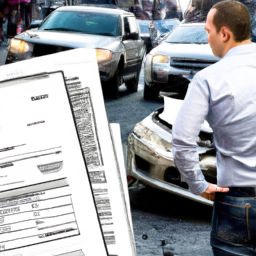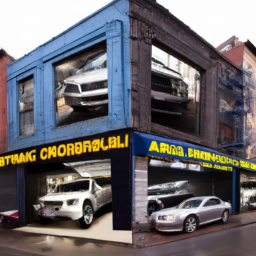Do you know what to do if you’re involved in an auto collision in NYC? Navigating the auto collision repair process can be overwhelming, but with the right knowledge, you can ensure a smooth experience. In this guide, we will provide you with everything you need to know about getting your vehicle repaired after an accident. From finding a reputable collision repair shop to understanding the insurance claims process, we will walk you through each step of the way. We will also discuss how to assess the extent of damage to your vehicle, obtain an accurate repair estimate, and navigate the rental car process. By the end of this guide, you will be well-equipped to handle any auto collision repair situation in NYC.
Finding a Reputable Collision Repair Shop
When looking for a reputable collision repair shop in NYC, start by asking trusted friends or family for recommendations. Choosing a reliable mechanic is crucial to ensure that your vehicle is repaired correctly and you are not taken advantage of. By seeking recommendations from people you trust, you can get firsthand information about their experiences with different repair shops. They can provide insight into the quality of work, customer service, and overall satisfaction with the repairs. Additionally, they can warn you about any repair scams or dishonest practices they may have encountered.
Avoiding common repair scams is essential to protect yourself and your wallet. Some common scams include unnecessary repairs, inflated prices, and using counterfeit or low-quality parts. By asking for recommendations from trusted individuals, you can reduce the chances of falling victim to these scams. It is also important to do your own research and read online reviews to get a broader understanding of the shop’s reputation. Look for certifications and affiliations with reputable organizations, such as the National Institute for Automotive Service Excellence (ASE). These certifications indicate that the mechanic has met specific standards of excellence in their field. Overall, taking the time to choose a reliable mechanic and avoid common repair scams will ensure that your collision repairs are done properly and at a fair price.
Understanding the Insurance Claims Process
To understand the insurance claims process for auto collision repair in NYC, you need to be aware of the steps involved and your role in the process. Dealing with insurance adjusters can be a complex task, but understanding the process can help make it smoother. Here are the key steps to keep in mind:
-
Reporting the claim: Contact your insurance company as soon as possible to report the accident and start the claims process. Provide all the necessary details about the collision, including the date, time, location, and any relevant documentation.
-
Adjuster’s assessment: An insurance adjuster will be assigned to your claim. They will evaluate the damage and estimate the cost of repairs. The adjuster may need to inspect your vehicle or request additional information.
-
Repair estimates: Obtain repair estimates from reputable collision repair shops. Submit these estimates to the insurance adjuster for review and approval.
-
Approval and payment: Once the adjuster approves the repairs, they will provide you with a payment for the cost of repairs, minus any deductible. The payment can be made directly to you or the repair shop, depending on your policy.
-
Choosing a repair shop: It’s important to select a reputable collision repair shop that is approved by your insurance company. They will work directly with the adjuster to ensure a smooth repair process.
Understanding the insurance claims process and effectively communicating with insurance adjusters can help expedite the auto collision repair process in NYC. By following these steps, you can ensure a seamless experience and get your vehicle back on the road as quickly as possible.
Assessing the Extent of Damage to Your Vehicle
Evaluate the damage to your vehicle by conducting a thorough inspection after the collision. Assessing the extent of damage is crucial in determining the necessary repairs and estimating the costs involved. Begin by visually inspecting your vehicle’s exterior for any visible signs of damage. Look for dents, scratches, or any misaligned parts. Pay attention to the condition of the paint, as any chipping or peeling could indicate underlying damage.
Next, inspect the interior of your vehicle. Check the functionality of the doors, windows, and any other movable parts. Look for any signs of broken or loose components. Don’t forget to examine the dashboard and control panels for any warning lights or malfunctions.
To ensure a more comprehensive assessment, it is advisable to take your vehicle to a trusted auto body shop. An experienced technician can perform a detailed inspection that includes checking the frame, suspension, and mechanical components. They can also use diagnostic tools to identify any hidden damages that may not be immediately visible.
Document the damage by taking clear photographs from various angles. This will serve as evidence when filing an insurance claim or negotiating with repair shops. Be sure to include close-up shots of any specific areas of concern.
Obtaining an Accurate Repair Estimate
After thoroughly assessing the extent of damage to your vehicle, it is time to move forward with obtaining an accurate repair estimate. Here are some important steps to consider:
- Research and contact multiple reputable auto repair shops in your area. Obtain estimates from each one to compare pricing and repair techniques.
- Provide detailed information about the damage to each shop. Be clear and specific about the areas affected and any additional repairs needed.
- Ask for a breakdown of the estimate. A good estimate should include labor costs, parts costs, and any additional fees or taxes.
- Negotiate pricing if necessary. Don’t be afraid to discuss the estimate with the repair shop and see if there is any room for adjustment.
- Don’t forget to factor in the reputation and experience of the repair shop. While price is important, it’s also crucial to choose a shop that has a good track record of quality repairs.
Navigating the Rental Car Process
Once you have obtained an accurate repair estimate for your vehicle, it is important to navigate the rental car process smoothly. When it comes to rental car options, you have a few choices to consider. Firstly, you can opt for a rental car from the insurance company recommended by your collision repair shop. This option is convenient as they often have partnerships with rental car companies and can arrange for a vehicle to be ready for you when you drop off your car for repairs. Another option is to choose a rental car company of your choice. However, in this case, you will be responsible for coordinating the rental car yourself and ensuring that the rental car company is willing to work with your insurance company for billing purposes.
When it comes to rental car coverage, it is important to understand your policy. Some insurance policies include rental car coverage, which means that your rental car expenses will be covered up to a certain amount while your car is being repaired. However, it is crucial to check the details of your policy, such as the daily limit and the duration of coverage, as these may vary. If your policy does not include rental car coverage, you may have the option to add it as an additional coverage for an extra premium. It is advisable to discuss your rental car options and coverage details with your insurance provider to ensure that you are adequately protected during the repair process.



